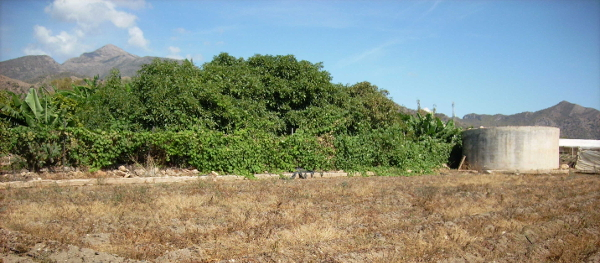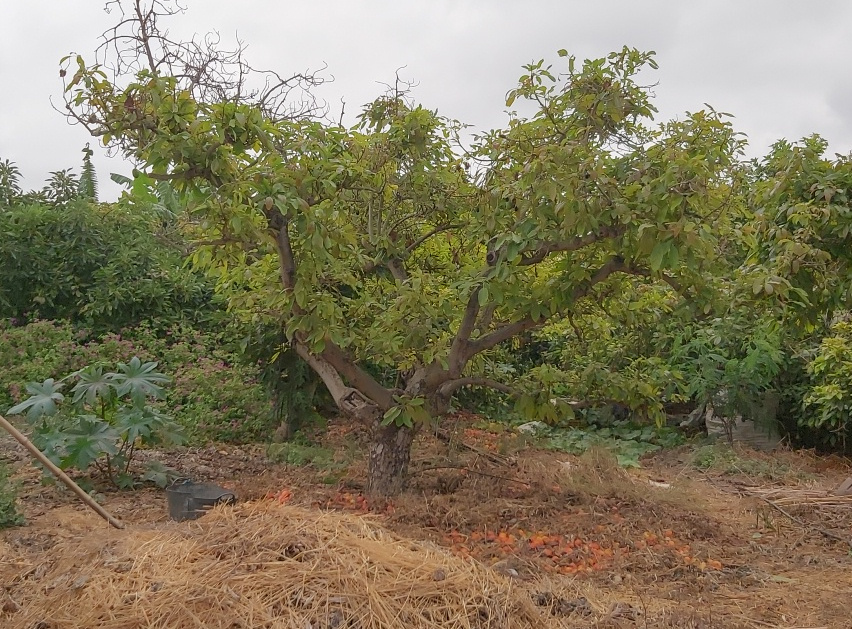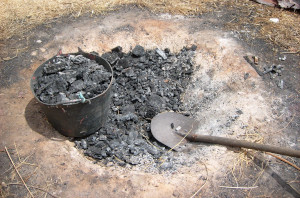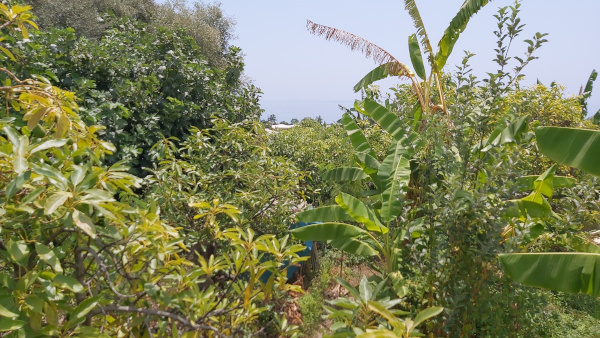Dez. 05 2023
How a barren avocado plantation became a forest garden
Español: Cómo una plantación de aguacates desnuda se convirtió en un jardín forestal
Polski: Jak naga plantacja awokado stała się leśnym ogrodem
Deutsch: Wie aus einer kahlen Avocadoplantage ein Waldgarten wurde
Plants grow almost everywhere on earth if we let them grow. New green, fertile oases can also be created on soils that have been degraded by civilisation (from the Roman Empire to EU agricultural policy) – whether in southern Europe, Germany or anywhere else in the world. The important thing is to restore the soil and water balance. This does not require expensive technology, but careful observation and many manual labour.
In 2015, the conversion to permaculture began on part of the site in southern Spain. The larger part of the current garden area was added in 2017, meaning that just over half a hectare is now being converted. Previously, the site was a pure avocado plantation that was conventionally cultivated with artificial fertilisers and pesticides. The soil was rock-hard from the sun, bare, almost without vegetation, with lots of stones. The avocado trees only bore a few fruits.
The conversion was based on the ideas of Bill Mollison and David Holmgren, who are regarded worldwide as the fathers of permaculture, and Sepp Holzer, the visionary and expert in natural farming and soil renaturalisation.
Mulching, mulching, mulching
Initially, the ground was covered with lots of recycled cardboard boxes to prevent further drying out. In addition, many sacks of greenery such as grass and hedge cuttings were added, followed later by wood scraps. This protected the soil from the strong sunlight that dried out the soil. This also protects the worms and microorganisms in the soil from the sun, heat, cold and wind. This allows them to reproduce better, decompose the organic material and enrich the soil with humus.
Caña (giant reed), which grows wild and abundantly in the area, was also cut into small pieces and used to cover the soil. This was followed by around 120 tonnes of avocado residue from an avocado processing factory, which was delivered by lorry. As far as possible, they were treated with bokashi juice (from lactic acid fermented kitchen waste), covered with chaff and film and thus also fermented before being applied to the soil. New humus layers were created on this basis.
Green manuring
Green manuring with legumes is a sustainable way to fertilise the soil. It is an environmentally conscious way to grow food organically and maintain soil fertility in the long term. Instead of buying expensively produced nitrogen to fertilise, you can use green manure, which benefits nature instead of harming it. Green manuring means sowing suitable plants and then working the plants (or parts of plants) into the soil.
The decomposition of the organic material improves soil fertility and the capacity to store water. The fruit trees are therefore better supplied with nutrients and water. The roots of the green manure plants protect the soil from erosion, loosen it and aerate it. This makes it easier for the roots of the fruit trees to spread.
Legumes are particularly suitable for green manure. They include plants such as clover, lupins, peas, lentils, beans and soya. But trees and shrubs also belong to the legume family. The best-known examples include mimosa, robinia and acacia. Legumes bind nitrogen from the air and bring it into the soil. They are helped in this by so-called nodule bacteria (rhizobia), which live in symbiosis with their roots. The rhizobia convert the nitrogen (N2) into ammonia (NH3) and thus make it biologically available. This conversion does not harm the environment, but rather benefits it. In conventional agriculture, some of the nitrogen fertiliser ends up in the groundwater and leads to nitrate pollution in our drinking water. However, if the nitrogen is bound as ammonia in the humus soil, it remains available to the plants for a longer period of time – especially in the charcoal content of Terra Preta.
One such leguminous tree is the evergreen white-headed mimosa (Leucaena leucocephala – from which the name of the finca was derived). It likes the warm climate in southern Spain and grows wild there. Seeds collected in the area were sown and grew into trees. After about 2 years, the first branches could be used as mulch.
On the way to Terra Preta
One challenge was the huge amount of prickly blackberries, which the previous owner encouraged to grow even more with a trimmer, as the roots of the blackberries remained in the ground after trimming and sprouted again. Thanks to the vegetative propagation of the blackberry through runners, the problem got worse and worse.
The dried blackberry plants, as well as other woody material, are processed into biochar for Terra Preta in an ErdKon-tiki. An Erdkontiki is a funnel-shaped hole (45 degrees) in the ground in which the material is carbonised due to a lack of oxygen and then slowly extinguished with water. (Kon-Tiki operating instructions.)
The charcoal obtained in this way is crushed, for example in a chopper together with cana and branches. The growing pile is then moistened with a jet of water. Finally, bokashi juice is poured over it, the pile is compacted and covered with foil. After three to six months, the charcoal is „charged“ and the material can be incorporated into the soil, e.g. for new plantings. The inclusion of charcoal has many positive effects:
- Due to the porosity and large surface area of charcoal, it stores water and nutrients for plants.
- It provides shelter for microorganisms and mycorrhiza and thus improves soil life and plant nutrition.
- The charcoal itself consists of 80 to 90 per cent carbon, which is hardly decomposed and thus remains in the soil in the long term. It is therefore a carbon sink that counteracts global warming.
- And more.
In the few years of conversion, it has of course not yet been possible to build up a metre-high layer of terra preta on the finca, as was the case with earlier Amazonian crops. But the first steps on this path are already encouraging …
Efforts and results
One aim of permaculture is to create sustainable ecosystems that provide people with food and require as little human intervention as possible. Depending on the initial situation, however, such a development can be lengthy and/or costly. The efforts involved in the conversion should not be concealed here – just think of the distribution of a total of 200 tonnes of biomass on the site! Bringing in biomass, processing it, digging it into the stony ground, growing it, planting it, mulching it, harvesting it, etc. all require a great deal of commitment, learning ability, physical effort and sometimes nerves of steel (it’s not just one person involved and this is not an academic laboratory situation;-). But it is already clearly visible, tangible (microclimate, walking barefoot) and palpable that this path is leading in a good direction.
Today, the garden is full of nutritious, healthy, delicious tropical fruits – avocados, bananas, papayas, mangoes, cherimoyas, guavas, passion fruit, loquats and more. In addition to the initial 100 or so avocado trees, there are now other fruit trees (mango, guava, cherimoya, loquat), over 30 large („quadrados“) and over 30 small („canarios“) banana plants, as well as more than 30 papaya plants („tree-shaped herb“). The cultivation of sugar cane, manioc, lemongrass, macadamia, grapes and vegetables has also begun.
Leucaenas (see above), senna, tagasaste, boldo, ricinius, golden acacia and other shade and biomass-providing auxiliary plants (A) grow in between. Ground cover plants such as nasturtium, „Jamaica thyme“ (B) and chayote complement the planting on the lower level of the forest garden. Overall, the soil is excellently protected and nourished – it is alive again and makes the plants productive.
However, it is not „only“ nature that is given a habitat worthy of the name, but also the people who live and work here with nature. If this half hectare seems insignificant in relation to the problems facing humanity, then it should be borne in mind that humanity is made up of many people (and cultures) who can bring a corresponding amount of land back to life in different situations. Without concrete, tried and tested alternatives, there will be no exit from the escalating catastrophes of the mega-machine, the capitalist world system. And „oh well, southern Spain … no frost, lots of sun … maybe it works there“ is not an effective counter-argument – permaculture works everywhere!
(A) The range of auxiliary plants is partly due to literature and partly to chance. The fact that some of these species are labelled as „invasive“ or „poisonous“ does not mean that they pose a „danger“ in the context of the finca. The list of plant species on the finca is also incomplete – there will be a follow-up article on the subject of „Biodiversity (flora and fauna)“.
(B) The misnomer „Jamaica thyme“ was probably due to its smell. However, the species is not related to thyme, but, as Plectranthus ornatus, belongs to the same genus as the aforementioned boldo (Plectranthus barbatus). This, in turn, should actually be called „false boldo“ („boldo-falso“), because the „true“ boldo in South America refers to a completely unrelated species. However, everyone around the finca simply calls Plectranthus barbatus „boldo“ and not „false boldo.“
Kommentare deaktiviert für How a barren avocado plantation became a forest garden



